Mobile Wallet Market Size
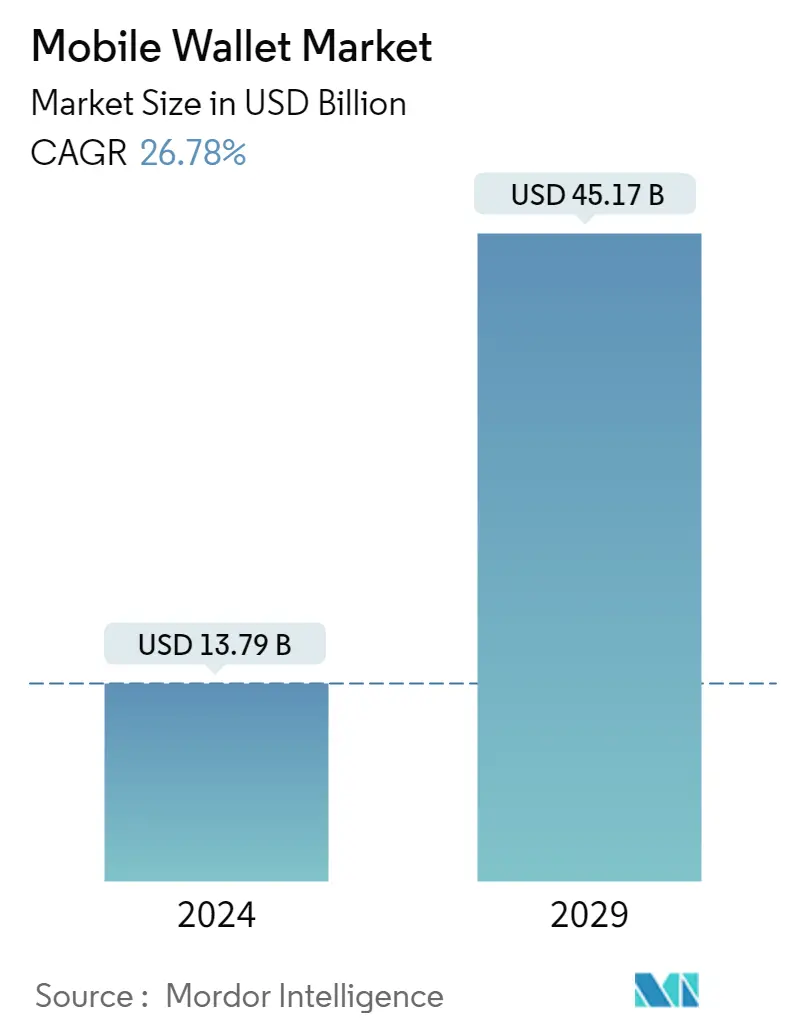
| Study Period | 2019 - 2029 |
| Market Size (2024) | USD 13.79 Billion |
| Market Size (2029) | USD 45.17 Billion |
| CAGR (2024 - 2029) | 26.78 % |
| Fastest Growing Market | Asia-Pacific |
| Largest Market | North America |
Major Players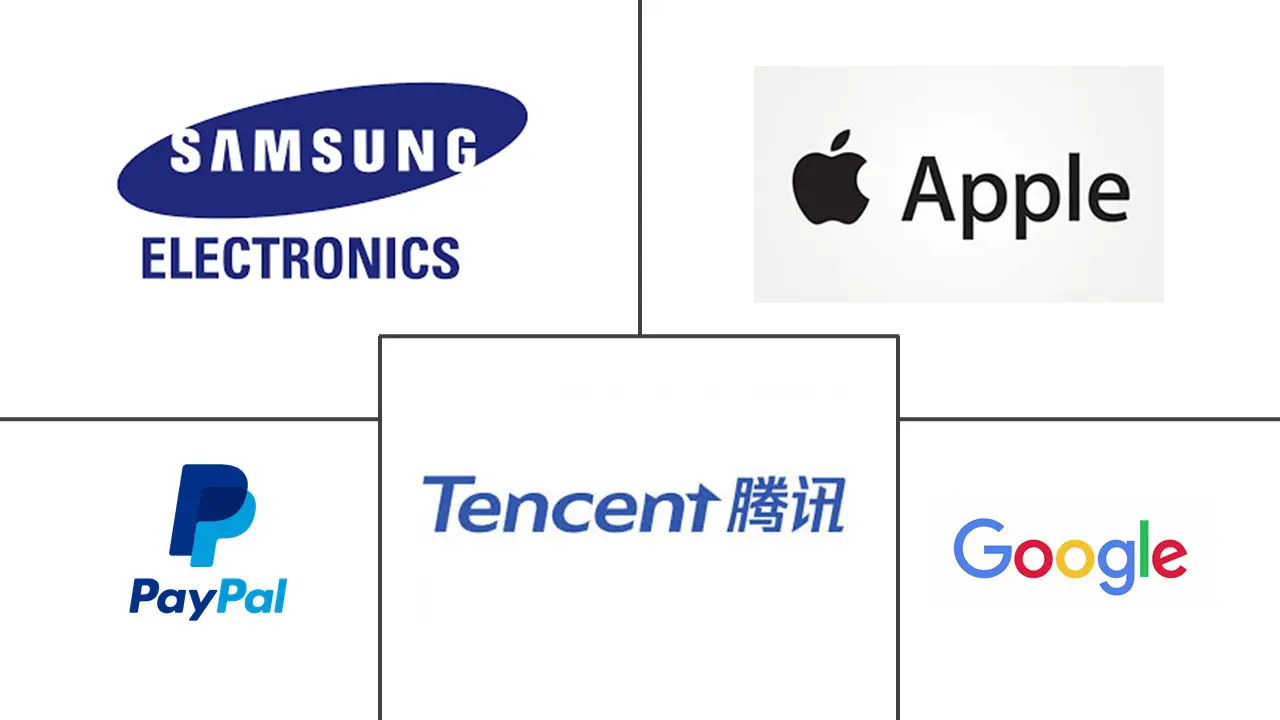
*Disclaimer: Major Players sorted in no particular order |
Need a report that reflects how COVID-19 has impacted this market and its growth?
Mobile Wallet Market Analysis
The Mobile Wallet Market size is estimated at USD 13.79 billion in 2024, and is expected to reach USD 45.17 billion by 2029, growing at a CAGR of 26.78% during the forecast period (2024-2029).
Over the years, the mode of payment has become increasingly streamlined, from cash to debit cards to online transactions. Additionally, the advent of eCommerce methods such as Paypal has initiated major mobile wallet adoption. Since then, the digital wallet concept has evolved, replacing the traditional physical-digital wallet. With the recent outbreak of COVID-19, the market is expected to witness significant growth owing to an increased usage of digital payment services. Over the years, the smartphone industry has seen rapid technological advancements in terms of features offered, such as NFC, 5G adoption, biometrics, encryption, and AI, among others, which are evident with greater penetration of smartphones in users' daily activities, thereby leveraging the growth of various industries, including the financial industry, which is leveraging the gaining momentum of growing smartphone users owing to the cost-effectiveness of smartphones.
- Furthermore, platforms such as eCommerce and mCommerce have played a significant role in changing users' habits when performing monetary transactions such as shopping by allowing users to enter their banking information into their respective wallets and enabling mobile phones as a mode of payment in place of credit and debit cards while ensuring security is handled on their side by leveraging technologies such as tokenization and essentially eliminating the risk of being stolen.
- Near-field communication, sound wave payments, and MST payments are examples of mobile-point-of-sale solutions that allow service and sales organizations to conduct monetary transactions in a flexible manner without being limited to a single location.allowing merchants to run mobility businesses such as food trucks and trade shows while improving the user experience, as is evident by major retailers' adoption of mPOS technology to support declining foot traffic. For instance, NFC powers the technology behind major mobile wallets like Apple Pay, Samsung Pay, and Google Pay.
- Additionally, mobile payment systems are expanding beyond the scope of smartphones and tablets with the use of wearable technology such as smartwatches and rings. Vendors are now embracing IoT while leveraging the potential of disruptive technologies such as blockchain to ensure the security of the transaction and counter concerns over data privacy. For instance, Apple Inc. offers services such as contactless payments, person-to-person payments, and transit cards through their mobile wallet and offers Apple Pay on their smartwatch, called the Apple Watch.
- The market benefited from the COVID-19 pandemic. Government laws and travel limitations led industry participants to temporarily close most of their offices, forcing them to alter their business practices. For example, NICE embraced hybrid and work-from-home work arrangements and limited staff travel. Most key market participants experienced increases in revenues throughout the epidemic, even though most acknowledged that the pandemic was a risk to their firm and were unsure of its impact. Mobile payments and digital transactions were propelled globally by the pandemic. It sped up the e-commerce sector's expansion into new markets, businesses, and product categories.
Mobile Wallet Market Trends
This section covers the major market trends shaping the Mobile Wallet Market according to our research experts:
Proximity Payments to Witness the Fastest Market Growth
- Although there are various proximity-based, payment-based mobile wallets available in the market, including NFC, UHF, MST, and location-based payments, among others, near-field communication, QR, and magnetic secure transmission are the leading technologies driving the market.
- NFC solutions enable users to seamlessly integrate existing payment cards through mobile phones, and the activation of payment services adds convenience and assured security. Even so, it makes contactless payments via wearables by leveraging tokenization. Also, it integrates with vending machines.
- Also, its low processing fees will help retailers achieve cost and operational efficiency and obtain data opportunities and loyalty, which could be used to improve customer relations. For instance, all the major mobile wallet vendors, such as Apple Inc., Google LLC, and Samsung Corporation, utilize NFC technology on their mobile wallets.
- Further, the trend will taper off as technology spreads among younger users. Gen Z, in particular, is expected to fuel growth as it obtains spending power. Baby boomers will continue to gravitate toward mobile wallets in tandem with increases in total digital adoption, partly due to the pandemic and partially because younger family members are encouraging them to do so.
- In an emerging market such as India, most smartphones do not come equipped with NFC technology, and people instead rely on the Unified Payment Interface (UPI) developed by the National Payments Corporation of India based on QR codes.
- Additionally, the acceptance of digital wallets continued undoubtedly in the last year, thanks to the alternatives that Apple Pay, Google Pay, and other critical mobile payment providers offered. The creation of digital wallets has been essential in providing a better, more practical, and frictionless payment procedure for individuals and, increasingly, businesses of all sorts. Accordingly, it is predicted that by the current year, 4.4 billion users worldwide will shop using a digital wallet, making up 52% of all e-commerce payments. Additionally, 1.6 billion consumers worldwide will make 30 percent of all POS payments using digital wallets in the current year.
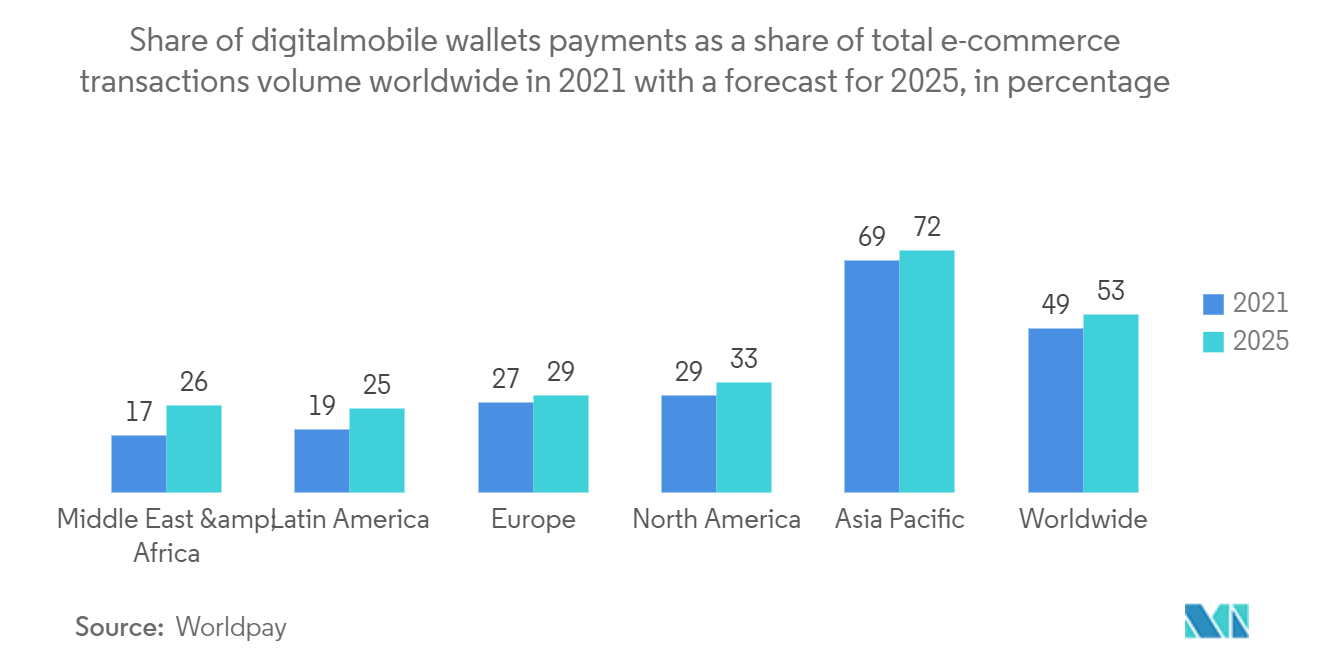
Asia-Pacific to Witness the Fastest Market Growth
- China has always been a major player in the mobile economy, leveraging its fintech firms to enable cashless payments across the country until recently. Southeast Asia is on the rise, owing to its strong economic growth and increased smartphone penetration.
- Also, the traditionally cash-reliant economy is leveraging the host of vendors in the region, such as ride-rentals, remittance firms, fintech startups, and banks, to provide people in Southeast Asia greater access to e-wallets, microloans, and insurtech products through smartphones. For instance, according to Forbes, Indonesia is one of the most mobile-first countries in the world, with 95% of internet users reported as mobile users.
- According to a Google, Temasek, and Bain & Company report, the Southeast Asia digital payment industry is projected to grow the gross transaction volume from USD 600 billion in 2019 to USD 1.1 trillion by 2025, with e-wallets sharing USD 22 billion in 2019 and USD 114 billion in 2025.
- At 59.9%, China now has the highest smartphone usage rate worldwide. India follows with a 43.5% utilization rate. The use of e-wallets is widespread in these nations. They are currently at the forefront of the payment revolution by providing security and convenience for payment processing. eWallets combine encryption, biometrics, tokenization, and device authentication via mobile applications, primarily driven by key players Alipay and WeChat, redefining the future's potential.
- Contactless payments are growing in acceptance as mobile commerce and digital wallets become more common. According to a recent study, nearly half of the 3,000 consumers polled used their smartphones to pay in-store at Starbucks (49%), McDonald's (43%), and Walmart (41%). Most contactless payments will be powered by hardware equipped with near-field communication (NFC) technology instead of app-based or digital wallet transactions. This includes card readers and cell phones with NFC capabilities. The infrastructure for NFC point-of-sale (POS) terminals must be purchased and set up by retailers, which incurs additional costs not present in soft POS systems, which are smart devices that contain both NFC and payment data.
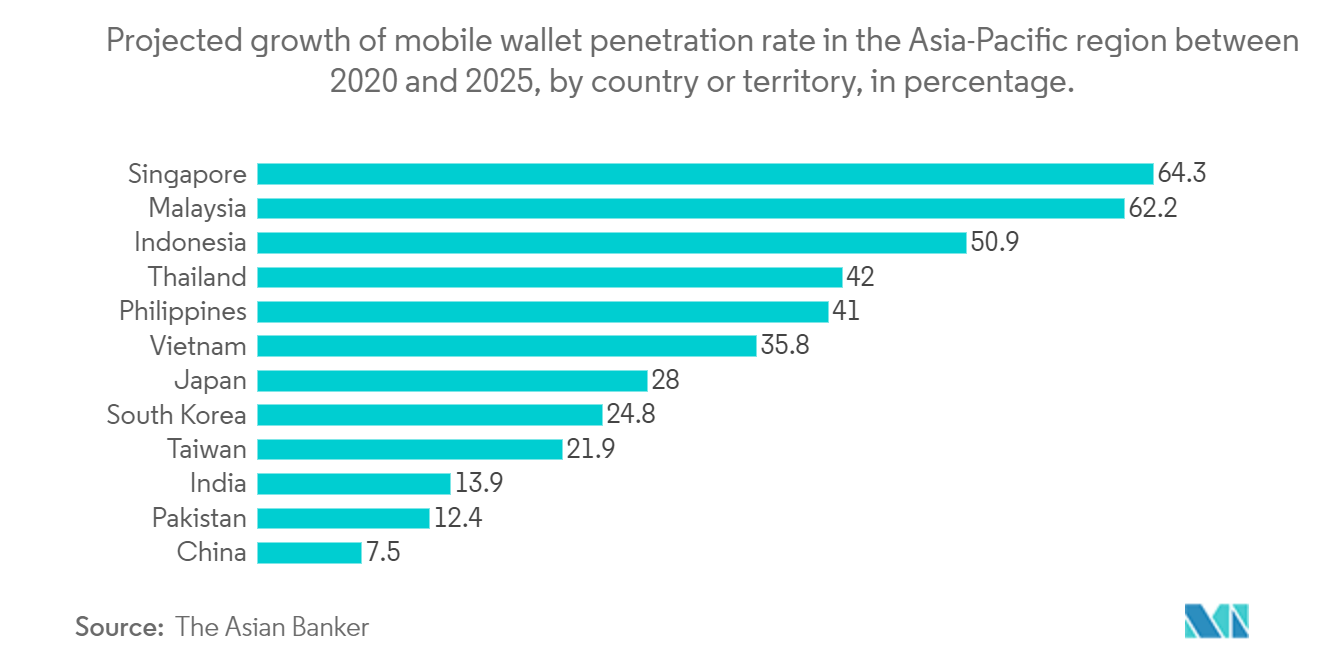
Mobile Wallet Industry Overview
The mobile wallet market is highly competitive and consists of several major players. In terms of market share, a few major players currently dominate the market. These major players with a prominent market share focus on expanding their customer base across foreign countries. These companies leverage strategic collaborative initiatives and acquisitions to increase their market share and profitability.
In September 2022, Alipay+, run by Ant Group, and Thunes, a global cross-border payments company, will join forces to allow the latter's European customers and merchants to accept payments through Asian companies' mobile wallets. KakaoPay in South Korea, Touch 'n Go in Malaysia, Boost in the Philippines, and Alipay in China are among the Asian mobile wallets that will be supported by the collaboration.Additionally included are the Thai services Rabbit, LINE Pay, and TrueMoney.
In June 2022, A partnership between leading Saudi-based telecommunications and digital service provider Mobily and MoneyGram International, Inc., a global company at the forefront of digital P2P payments, enabled the launch of MoneyGram's industry-leading international money transfer capabilities on Mobily Pay. Through this partnership, millions of Saudi Arabian consumers would instantly send money internationally using the Mobily Pay mobile wallet.
Mobile Wallet Market Leaders
Apple Inc
Google LLC
Tencent
PayPal
Samsung Electronics
*Disclaimer: Major Players sorted in no particular order
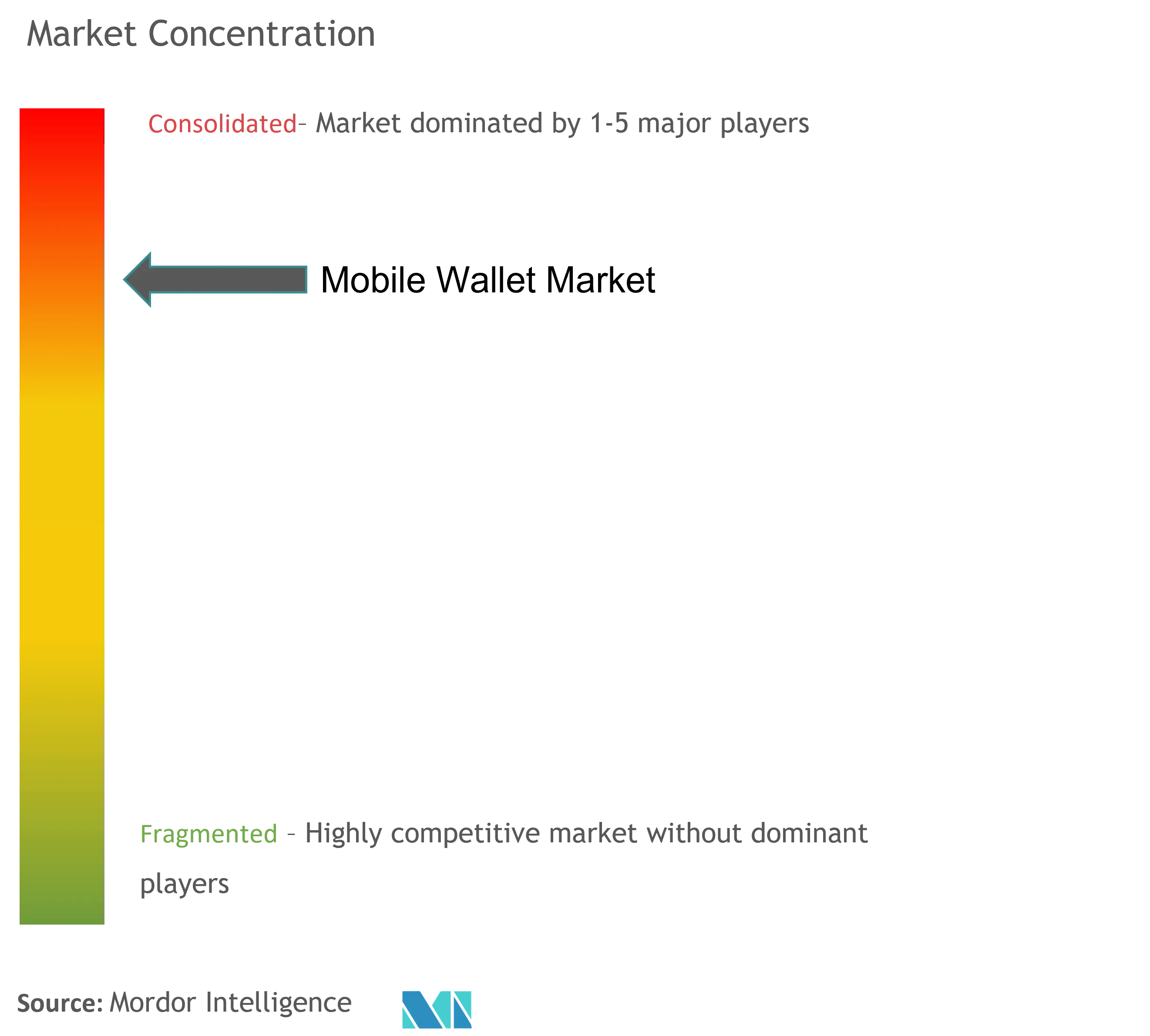
Mobile Wallet Market News
- October 2022: A digital payment and banking technology developer, i2c Inc., recently announced the introduction of SHAREPay and its cooperation with Majid Al Futtaim, a leader in shopping centers, communities, retail, and leisure in the Middle East, Africa, and Asia. A component of this solution is the region's top loyalty program, SHARE by Majid Al Futtaim, which enables users to "pay, earn, and redeem" points with only one tap.
- September 2022: In an attempt to collaboratively promote cashless travel in the nation, leading mobile payment providers from around Asia announced the integration of Alipay + cross-border digital payment solutions in South Korea. Due to the partnership, leading mobile payment companies from Southeast Asia and Hong Kong will now be able to extend the availability of their services in South Korea via Alipay for the first time.
Mobile Wallet Market Report - Table of Contents
1. INTRODUCTION
1.1 Market Definition and Scope
1.2 Study Assumptions
2. RESEARCH METHODOLOGY
3. EXECUTIVE SUMMARY
4. MARKET INSIGHTS
4.1 Market Overview
4.2 Industry Stakeholder Analysis
4.3 Industry Attractiveness - Porter's Five Forces Analysis
4.3.1 Bargaining Power of Suppliers
4.3.2 Bargaining Power of Consumers
4.3.3 Threat of New Entrants
4.3.4 Threat of Substitute Products
4.3.5 Intensity of Competitive Rivalry
5. MARKET DYNAMICS
5.1 Market Drivers
5.1.1 Growth of smartphone and proximity payment
5.1.2 Government initiative towards digital transformation
5.1.3 Growth of e-commerce platforms
5.2 Market Restraints
5.2.1 Data Privacy concerns by end-users
5.3 Impact of COVID-19 on Mobile wallet Market
6. MARKET SEGMENTATION
6.1 Mode of Payment
6.1.1 Proximity ( NFC,Sound waves-based payments,Magnetic secure transmission (MST) payments,Quick response (QR) code payments)
6.1.2 Remote Payment (Internet payments,SMS payments,Direct carrier billing,Mobile banking)
6.2 Application
6.2.1 Mobile Commerce
6.2.2 Money Transfer
6.2.3 Micropayment
6.2.4 Retail
6.2.5 Restaurant
6.2.6 Public Transport
6.3 Geography
6.3.1 North America
6.3.1.1 United States
6.3.1.2 Canada
6.3.2 Europe
6.3.2.1 Germany
6.3.2.2 UK
6.3.2.3 France
6.3.2.4 Spain
6.3.2.5 Rest of Europe
6.3.3 Asia-Pacific
6.3.3.1 China
6.3.3.2 Japan
6.3.3.3 India
6.3.3.4 Australia
6.3.3.5 Rest of Asia-Pacific
6.3.4 Latin America
6.3.4.1 Brazil
6.3.4.2 Mexico
6.3.4.3 Argentina
6.3.4.4 Rest of Latin America
6.3.5 Middle East and Africa
6.3.5.1 UAE
6.3.5.2 Saudi Arabia
6.3.5.3 South Africa
6.3.5.4 Rest of Middle East and Africa
7. COMPETITIVE LANDSCAPE
7.1 Company Profiles
7.1.1 Apple Inc
7.1.2 Google Inc
7.1.3 Tencent Holdings Ltd.
7.1.4 PayPal Holdings, Inc.
7.1.5 Samsung Electronics Co., Ltd.
7.1.6 MasterCard Incorporated
7.1.7 Visa Inc.
7.1.8 Ant Financial Services Group
7.1.9 JP Morgan Chase &Co.
7.1.10 Mobikwik
7.1.11 Paytm
7.1.12 The American Express Company
7.1.13 First Data Corporation
- *List Not Exhaustive
8. INVESTMENT ANALYSIS
9. MARKET OPPORTUNITIES AND FUTURE TRENDS
Mobile Wallet Industry Segmentation
The mobile wallet, also known as a digital wallet or eWallet, refers to the mobile technology that provides a seamless solution for any business looking to allow users to purchase products in-store and online with added convenience in order to generate further sales. It is a virtual wallet that stores information such as payment cards, including credit and debit cards, and rewards cards on a mobile phone while ensuring the security of such sensitive information.
The Mobile Wallet Market is segmented by Mode of Payment (Proximity, Remote), Application (Mobile Commerce, Money Transfer, Micropayment, Retail, Restaurants, Public Transport), and Geography (North America (United States, Canada), Europe (Germany, UK, France, Spain, and Rest of Europe), Asia Pacific (China, Japan, India, Australia, and Rest of Asia-Pacific), and Latin America (Brazil, Mexico, Argentina, and Rest of Latin America), and Middle East & Africa (UAE, Saudi Arabia, South Africa, and Rest of MEA). The market sizes and forecasts are provided in terms of value (USD million) for all the above segments.
| Mode of Payment | |
| Proximity ( NFC,Sound waves-based payments,Magnetic secure transmission (MST) payments,Quick response (QR) code payments) | |
| Remote Payment (Internet payments,SMS payments,Direct carrier billing,Mobile banking) |
| Application | |
| Mobile Commerce | |
| Money Transfer | |
| Micropayment | |
| Retail | |
| Restaurant | |
| Public Transport |
| Geography | |||||||
| |||||||
| |||||||
| |||||||
| |||||||
|
Mobile Wallet Market Research FAQs
How big is the Mobile Wallet Market?
The Mobile Wallet Market size is expected to reach USD 13.79 billion in 2024 and grow at a CAGR of 26.78% to reach USD 45.17 billion by 2029.
What is the current Mobile Wallet Market size?
In 2024, the Mobile Wallet Market size is expected to reach USD 13.79 billion.
Who are the key players in Mobile Wallet Market?
Apple Inc, Google LLC, Tencent, PayPal and Samsung Electronics are the major companies operating in the Mobile Wallet Market.
Which is the fastest growing region in Mobile Wallet Market?
Asia-Pacific is estimated to grow at the highest CAGR over the forecast period (2024-2029).
Which region has the biggest share in Mobile Wallet Market?
In 2024, the North America accounts for the largest market share in Mobile Wallet Market.
What years does this Mobile Wallet Market cover, and what was the market size in 2023?
In 2023, the Mobile Wallet Market size was estimated at USD 10.88 billion. The report covers the Mobile Wallet Market historical market size for years: 2019, 2020, 2021, 2022 and 2023. The report also forecasts the Mobile Wallet Market size for years: 2024, 2025, 2026, 2027, 2028 and 2029.
What are the emerging technologies shaping the future of Mobile wallets Market?
The emerging technologies shaping the future of the Mobile Wallets Market are a) Integration with biometrics (fingerprint, facial recognition) b) Blockchain technology
Mobile Wallet Industry Report
The mobile wallet industry is witnessing a significant surge, driven by the increasing use of smartphones, internet access, and the booming e-commerce sector. This growth is underscored by the convenience and security mobile wallets offer, facilitating a variety of transactions and the adoption of contactless payments, especially highlighted during recent global health crises. Innovations like biometric authentication are enhancing security and user experience, contributing to the robust virtual wallet growth rate. The industry's expansion is notable across tech companies, banks, and telecom operators, with the Asia Pacific region leading in adoption due to high smartphone usage and digital literacy. Despite challenges like security concerns and limited merchant acceptance, the future looks promising with ongoing technological advancements and a shift towards digital transactions. For detailed insights, Mordor Intelligence™ provides comprehensive analysis on the mobile wallet market share, size, revenue growth rate, including a market forecast and historical overview, available as a free report PDF download.
